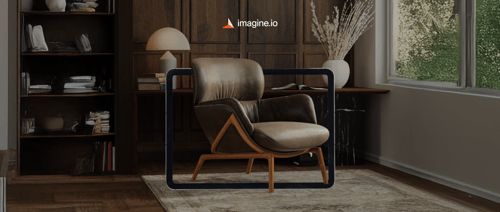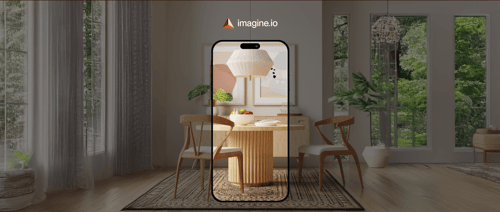Imagine you're browsing an online store for a new sofa, but the flat product image leaves you wondering how that velvet upholstery would look in your living room. Now, with a single tap, your phone's camera transforms the experience, overlaying a lifelike 3D model of the sofa into your space. You adjust the color, test different fabrics, and see it from every angle all in real time. This isn't science fiction; it's the power of augmented reality (AR), and it's revolutionizing how textile brands engage customers, boost conversions, and build trust in the digital marketplace.
AR: Redefining Textile eCommerce
The tactile allure of textiles whether it's the softness of a comforter, the sheen of silk curtains, or the texture of a wool rug makes online selling a challenge. Static images and vague descriptions often fall short, leaving shoppers uncertain. Augmented reality changes that by letting customers visualize products in their own environment, bridging the gap between digital and physical shopping. A 2025 report projects the virtual try-on market to grow from $5.77 billion in 2024 to $27.71 billion by 2031, with a robust 25.5% CAGR. For textile brands, AR isn't just a tool it's a strategic advantage.
Platforms like imagine.io are leading the charge, enabling brands to create photorealistic 3D visualizations without requiring advanced technical skills. By uploading a single product model, companies can generate images, videos, 360-degree views, and interactive configurators in minutes. This efficiency is critical for brands operating in key markets like New York, Los Angeles, Chicago, and Canada, where imagine.io's customers such as Ruggable, SertaSimmons, and Kohler are already seeing transformative results.
Why AR Matters for Textiles
The rise of online shopping, fueled by post-COVID digital habits, has shifted consumer expectations toward immersive, personalized experiences. With AR-enabled smartphones now ubiquitous, mobile AR outperforms desktop implementations by 33%, offering shoppers the flexibility to interact with products anywhere. Social media platforms like Instagram, LinkedIn, and YouTube where imagine.io's target audience engages amplify this trend. AR integrations in social commerce channels turn casual scrolling into confident purchasing decisions.
Textiles are inherently high-touch purchases. A customer might hesitate over a $600 bedding set, unsure if the color or fabric will suit their space. AR eliminates this uncertainty by allowing real-time visualization. For example, a home decor brand can let shoppers preview curtains in their living room, adjusting patterns and lengths instantly. Data backs this up: strategically implemented AR experiences can increase conversion rates by up to 189%, with virtual try-on solutions showing the strongest gains in textiles and apparel.
Textile Brands Winning with AR
Real-world results tell a compelling story. A home textile brand, similar to Ruggable, integrated imagine.io's AR viewers into its product pages and saw a 28% jump in conversions. Shoppers could visualize rugs in their homes, experimenting with sizes and designs, which reduced cart abandonment and boosted sales. Another direct-to-consumer fashion label cut return rates by 35% using AR-powered previews that let customers see how fabrics and fits looked on their body. These tools empower buyers to make informed choices, minimizing the costly guesswork that leads to returns.
Imagine.io's all-in-one platform sets it apart from competitors. While others focus on single-use cases like images or videos, imagine.io delivers everything photorealistic renders, interactive 360 views, and AR try-ons. Studies show its outputs are so lifelike that eCommerce experts can't distinguish them from traditional photoshoots. For brands like King Koil or Hunter Fan, operating in competitive markets like Dallas and Las Vegas, this means launching seasonal collections faster and with greater impact.
Case Study: Scaling with Speed
Consider a bedding brand rolling out a new line of luxury quilts. Traditional photoshoots for every color and size could take weeks and cost thousands. With imagine.io, the brand uploads one 3D model and generates unlimited assets images, videos, and AR experiences in minutes. This speed is a game-changer for high-volume catalogs, like those managed by PepsiCo or Diageo, ensuring they stay agile in fast-moving markets without compromising quality.
Navigating AR Adoption Challenges
Adopting AR isn't without hurdles. Some brands hesitate at imagine.io's subscription model, preferring one-off project costs. Others find the custom pricing tailored to each client's needs less straightforward than competitor's flat rates. Smaller textile sellers, particularly those outside established agency networks, worry about technical complexity. Will their team need extensive training? Can AR integrate with their eCommerce platform? And will it work across all customer devices?
These concerns are real but addressable. Imagine.io's no-code platform requires no 3D expertise, making it accessible for lean teams. As AR-enabled devices become standard, compatibility issues are fading. Cloud-based solutions ensure seamless integration with platforms like Shopify, used by brands like KegWorks. While subscriptions may seem daunting, the ability to create unlimited assets at scale often outweighs the cost, especially for brands with diverse product lines.
The Business Impact: Trust and Profitability
AR delivers measurable results. Beyond the 189% conversion boost, 3D visualization in home furnishings cuts return rates by up to 40% by ensuring customers know exactly what they're buying. For high-consideration purchases like custom upholstery or premium bedding, AR shortens decision cycles, driving sales. Embedding AR viewers on product pages also improves SEO and dwell time, as shoppers spend more time interacting with products. For brands like KitchenAid or Amana, this translates to stronger customer loyalty and repeat business.
Social media amplifies AR's reach. A 2021 Time article showcased Nike's AR try-on for sneakers, noting its success in engaging younger audiences on platforms like Snapchat. Textile brands can leverage similar strategies on Instagram and Facebook, where imagine.io's customers are active, embedding AR experiences in ads to drive clicks and conversions.
AR also enhances personalization. Data shows personalized AR experiences drive 27% higher engagement than generic ones, allowing brands to tailor visuals to individual preferences whether it's adjusting a curtain's color or previewing a sofa's fabric. This level of customization builds trust, particularly in markets like Austin and High Point, where discerning customers demand precision.
AR: A Must-Have for Textile Brands
“Textile brands using AR are not just keeping up they're setting the pace,” says an imagine.io executive. With the virtual try-on market poised to hit $27.71 billion by 2031, AR is no longer optional; it's essential. As virtual try-ons reshape retail, brands that adopt AR early will gain a competitive edge. The good news? Platforms like imagine.io make it easy, offering no-code solutions that scale effortlessly, whether for a single product or an entire catalog.
For textile brands in Chicago, Canada, or beyond, the path forward is clear. Start with a pilot test AR on a flagship product and measure the lift in engagement. As one brand noted, “With imagine.io, our returns plummeted, and customer satisfaction soared.” In a digital-first world, AR isn't just a tool it's the future of textile eCommerce, delivering trust, conversions, and a shopping experience that feels as real as it gets.
Frequently Asked Questions
How much can AR improve conversion rates for textile brands?
AR experiences can boost conversion rates by up to 189% for textile brands, with virtual try-on solutions showing particularly strong gains in textiles and apparel. Additionally, AR visualization in home furnishings can reduce return rates by up to 40% by helping customers make more informed purchasing decisions before buying.
What makes AR particularly beneficial for selling textiles online?
Textiles are inherently high-touch purchases where customers need to feel confident about fabric texture, color, and how items will look in their space. AR bridges this gap by allowing shoppers to visualize products like rugs, curtains, or bedding in their own environment in real-time, eliminating the uncertainty that comes with static product images and reducing costly returns.
Is AR technology difficult to implement for textile eCommerce stores?
Modern AR platforms like imagine.io offer no-code solutions that require no 3D expertise, making AR accessible even for lean teams without technical backgrounds. These cloud-based platforms integrate seamlessly with popular eCommerce platforms like Shopify, and with AR-enabled smartphones now standard, compatibility issues are becoming less of a concern for brands looking to adopt this technology.
Disclaimer: The above helpful resources content contains personal opinions and experiences. The information provided is for general knowledge and does not constitute professional advice.
You may also be interested in: Why the Future of Product Photography is Virtual: The Rise of 3D Rendering
Struggling with expensive, outdated product visuals that slow down your creative process and stunt eCommerce growth? imagine.io's AI-powered platform empowers furniture, home décor, and textile brands to effortlessly produce striking 3D images, immersive videos, AR experiences, and interactive configurators. Cut production costs up to 70%, boost conversions 5X, speed up prototyping, and supercharge your online sales. Ready to elevate your product visuals and captivate customers? Book a demo with imagine.io today!
Powered by flareAI.co




.png?width=500&name=How%20to%20Add%20a%203D%20Product%20Configurator%20to%20Your%20WordPress%20Website%20(Complete%20B2B%20Guide).png)
















%20(1).png?width=500&name=Why%20Exploded%20Mattress%20Views%20Matter%20(And%20How%20to%20Generate%20Them)%20(1).png)
.png?width=500&name=Best%20Shopify%20Product%20Configurator_%20How%20to%20Choose%20the%20Right%20One%20(2).png)
.png?width=500&name=Why%20Exploded%20Mattress%20Views%20Matter%20(And%20How%20to%20Generate%20Them).png)



.png?width=500&name=Best%20Shopify%20Product%20Configurator_%20How%20to%20Choose%20the%20Right%20One%20(1).png)







.png?width=500&name=How%203D%20Rendering%20Can%20Make%20or%20Break%20Your%20Industrial%20Design%20Pitch%20(1).png)








%20with%20Digital%20Twins%20and%203D%20Visualization.png?width=500&name=Optimizing%20Your%20Digital%20Asset%20Management%20(DAM)%20with%20Digital%20Twins%20and%203D%20Visualization.png)




.png?width=500&name=Styling%20Home%20Decor%20for%202025_%20From%20Global%20Influences%20to%20Playful%20Personalization%20(1).png)
